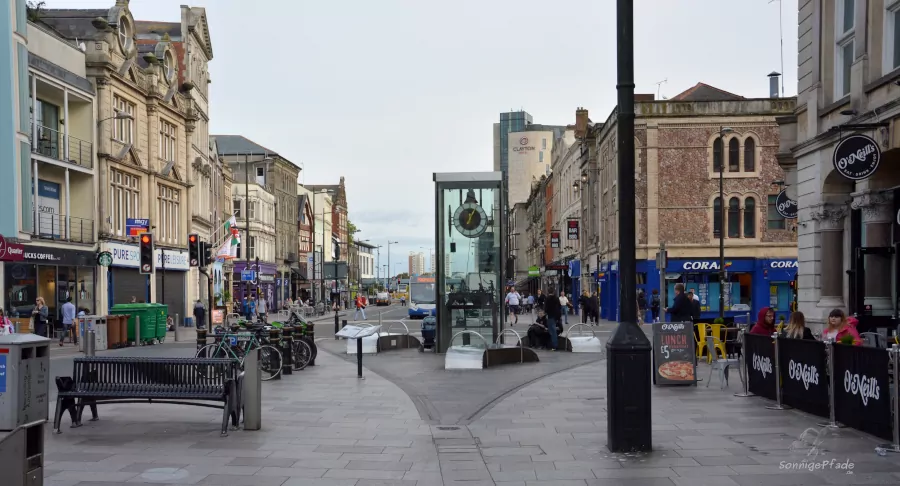
If you want to see more than just London on the British main island, it’s worth taking a trip further west – to Wales. And there, the Welsh capital Cardiff is a good starting point for further explorations.
From coal industry to liveable city – discover Cardiff
The origins of the city and castle of Cardiff
Cardiff is located on the wide westward facing funnel mouth of the Severn River. Welsh is the name of Cardiff: Caer Dydd. This is traced back to the place name fortress Caer on the Taff (older: Diff or just Dydd), whereby the Taff is a smaller river. This river crosses the city from north to south and then flows into the Severn in Cardiff Bay. The Severn’s funnel forms the southern border of Wales.
The region has been settled since the Neolithic Age, about 6000 years ago. Before the Romans built a first fortress and military settlement around 75 AD, mainly Celtic Silurians were at home in the area. The Romans stayed for about 250 years and then abandoned their fort. After that, there were hardly any continuous inhabitants for a long time, until another fort was built in 1081. As a result, Cardiff was first mentioned in a document in 1093. In the shadow of the castle, a city developed, which for a long time had little significance.
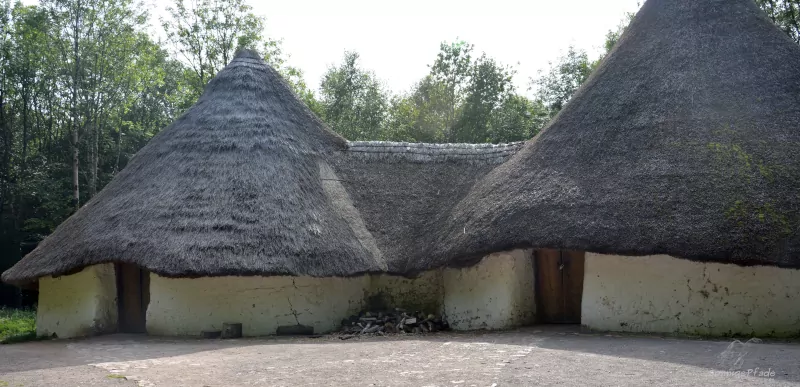
Cardiff’s development in the course of the industrial revolution
It was not until the 19th century that Cardiff began a rapid rise in coal mining and industrialization. Cardiff Bay was developed into the world’s largest coal port for a time and almost all Welsh coal was shipped through Cardiff.
Naturally, the city became an industrial city for the first time. Since 1883 there is a university, since 1955 Cardiff is the capital of Wales. Currently, about 370,000 inhabitants live in Cardiff.
As is often the case in industrial cities, the necessary infrastructure was well developed, but no particular emphasis was placed on design and quality of life during this founding phase. It was only with the decline of coal production that a qualitative change set in. And that is something to be proud of. Cardiff is now well worth a visit and a good base for exploring South Wales.
Attractions in the City of Cardiff

The city center of Cardiff is dominated by a pedestrian zone with several shopping streets. (Queen Street, High Street..) A stroll already gives a nice impression, but is not much more varied than in other big cities. Those who like shopping will find their shops in Cardiff. Those who have to wait for the shoppers will be happy about one or the other bar. A few rustic pubs and bars with down-to-earth, well-seasoned food offerings won’t leave you starving.
If you want to get an overview of the city and the attractions, you can treat yourself to a 24h hop-on/hop-off bus ticket* and discover Cardiff with the open double-decker buses. With the bus ticket you get a discount on the entrance fee to Cardiff Castle. A guided city tour* can also increase your enthusiasm for Cardiff and the sights of the Welsh capital. The tour will even take you to small attractions that you would easily miss on your own.

On Castle Street there are several souvenir stores next to each other. There you get to know the green-white Welsh national flags with the red dragon. It fits well to Wales – in the mountainous, Atlantic landscape with castles and castle ruins you can let your imagination run wild and dream of fairies, dragons, knights and damsels.
At one of the souvenir – stores above the shop windows the notice „190 miles to…“ well, the Welsh village with the long name, which means as much as: „The church of St.Mary’s in the hollow of the white hazel near the rapid whirlpool and the church of St. Tysilio’s by the red cave“ all written together in one word, without periods and commas. The longest name of a place known in the western world.
West of the center, the river Taff crosses under Castle Street. There rises the Milennium Stadium, a modern sports complex for soccer and rugby games, which can even be completely covered. Opposite begins the Bute Park, which stretches northward along the Taff River and is very popular with Cardiff residents and visitors for relaxation in the green.

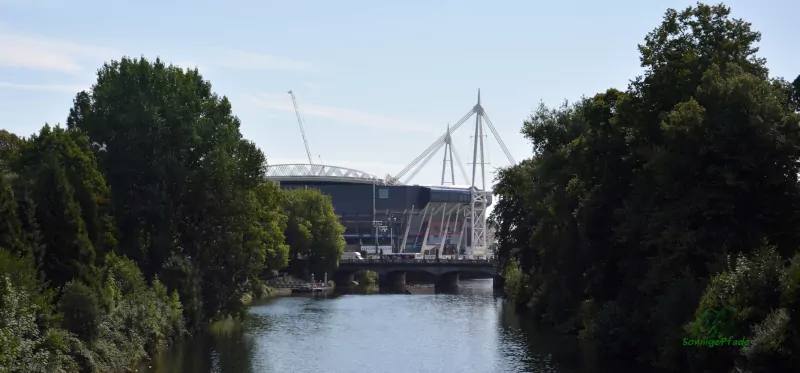
Cardiff Castle – castle, fortress, palace
Just opposite the northern end of the pedestrian zone (High Street) is Cardiff Castle. The fortress of Cardiff, probably the biggest tourist attraction of the Welsh capital.
Cardiff Castle is surrounded by a fortress wall. The main gate with the visitor information is located in Castle Street. Inside the fortress is a rather spacious square. This is partly used for events to give a little medieval feeling. A reconstructed slingshot stands in the eastern quarter, and there are also remains of other defenses and fortified warehouses. On the eastern wall you can walk along and look at the whole area from above. One floor below, in the closed rooms of the fortress wall, the period of the Second World War is remembered. Because when the British Isles were under the bombardment of the German Luftwaffe, these rooms served as air raid shelters – bunkers. The furnishings of that time have been reconstructed (including canteen and first aid station) and a few audio effects add drama.
Cardiff Castle was originally built at the end of the 11th century on the remains of the old Roman fort.

At the time of Cardiff’s foundation, i.e. from 1081, a so-called motte was first erected as a fortification. This consists of an artificially heaped up earth wall and a fortress tower built on it. Originally, this was probably a wooden tower with a palisade ring, later these were replaced by stone structures. The first castles had, besides relatively simple ramparts, mainly a massive tower with a large living room on the second floor. This motte can be found in the back part of the castle square.
The use of the castle and the expenditures for its extension and reconstruction changed frequently with its owners. The western buildings were rebuilt in the middle of the 19th century into representative residential buildings in the style of a romantic fairy-tale castle. This part is visibly younger in contrast to the fortifications, but it fits very well into the surroundings and is also an attractive part of Cardiff Castle today. The rooms are used, among other things, for representative weddings.

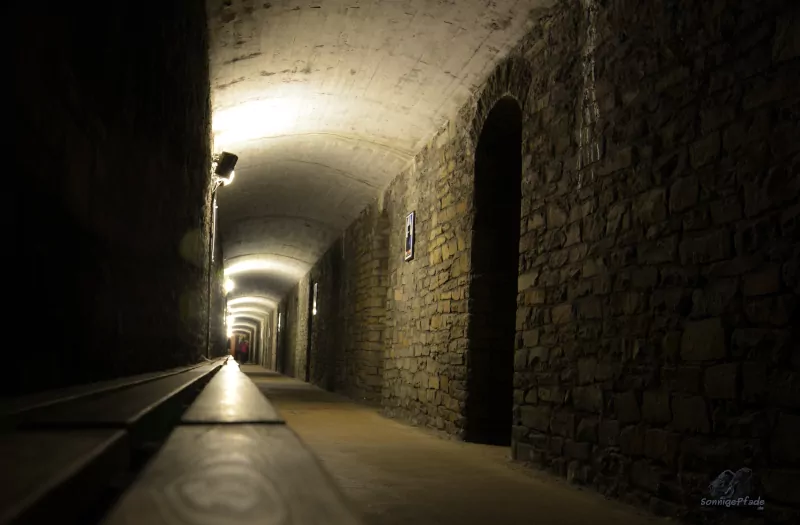
The bay at the Severn – Cardiff Bay
Cardiff Bay was once the world’s largest coal port and has contributed significantly to the development of the city. After the decline of coal mining, the harbor and the surrounding district became one of Cardiff’s most attractive gems through active urban development. If you have enough time, you can at least walk there… maybe along the River Taff, then you won’t miss Cardiff Bay.
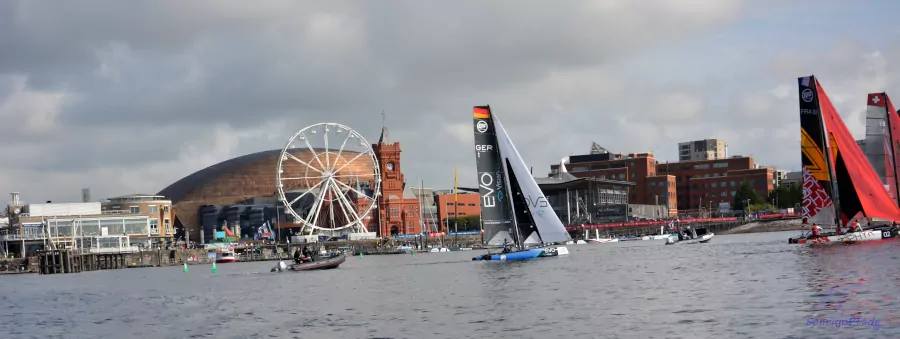
As always, open waters on the outskirts of the city have their special charm. Cardiff Bay is no different. From the shore, the view sweeps far across the bay, which is bordered to the south by a mountain range. The actual exit is not really noticeable. There are still the remains of old harbor facilities with large lock gates. But in the meantime the bay has become more of a recreational domicile. Sailors in particular use the waters for a beat in front of the harbor.
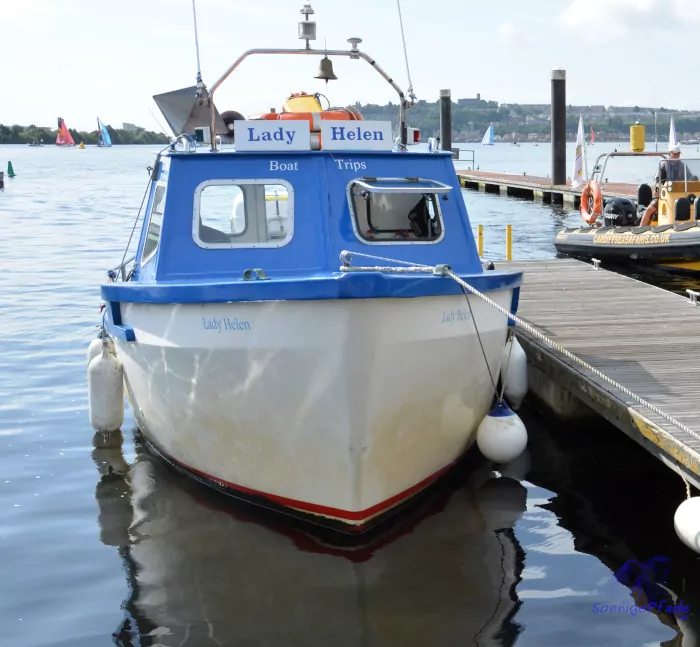
You can take a cruise on the „Helen“ motor boat for a small fee and see the Cardiff Bay area from the water. Next to the old brick building of the harbor mastery is a large modern building: The Senedd (Senate), the Welsh Parliament. Behind it a new shopping center and the golden-bronze shimmering Welsh Opera. The squares in between are often the scene of carnivals and other amusements – many Cardiff residents take advantage of sunny days to take a short trip by city bus to Cardiff Bay. There are also seafaring traditions. A monument in the shape of a lying face, inside with ribs like a ship’s hull, commemorates sailors who fell victim to shipwrecks.
If you don’t want to walk back, you have two alternatives. One is, of course, the city bus. On the Taff, however, there is also an „Aquabus“ to the center or to the Millennium Stadium.
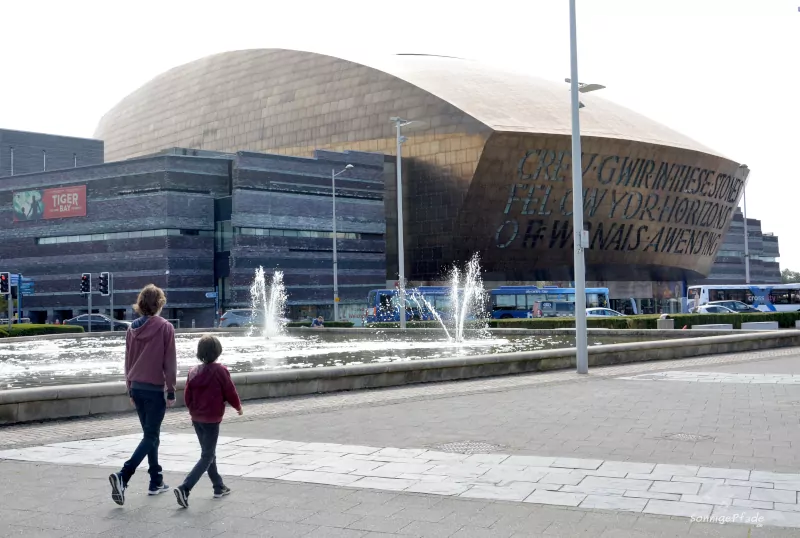
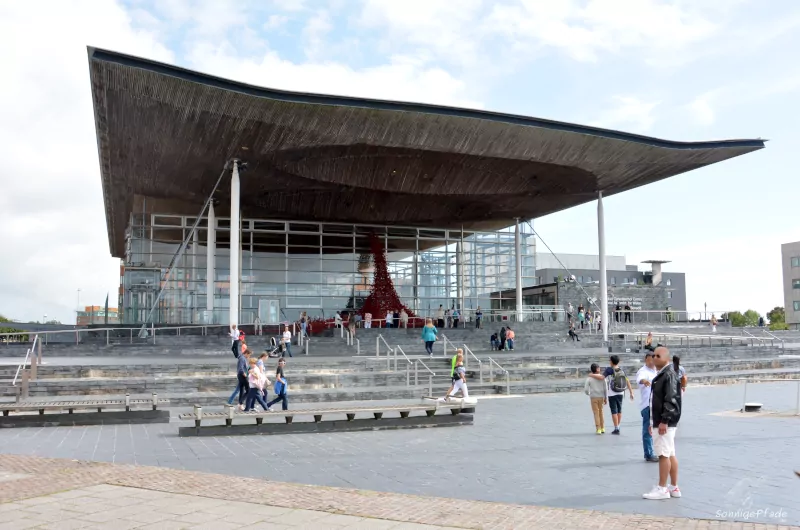
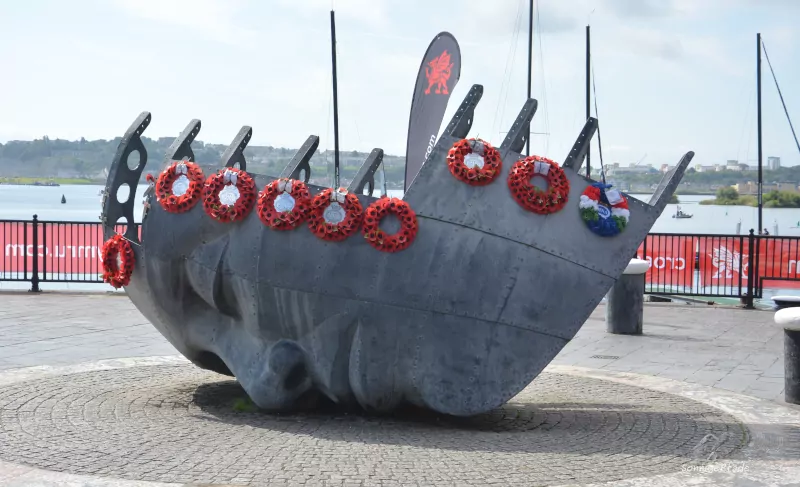
A day at the Museum of Welsh Life
In the suburban district of St. Fagan you will find a special attraction of Cardiff: St.Fagan Castle and the Museum of Welsh Life. The grounds of the castle park and beyond have been developed into an open-air exhibition of the development of Wales, offering enough for a day visit.

In the castle itself, the service rooms such as the kitchen have just been restored, as if everything was prepared for a huge banquet in the next few days. You can also take a look into the „good room“. In the castle’s garden, herbs and flowers are being prepared for the feast day, and experiments are also being carried out with roses or flowering meadows.
In one of the back corners of the castle park there is a fishery and not far from it an original weaving room. Many of the handicraft trades are actively supervised – if you are lucky, you can watch the weaving at the large looms.
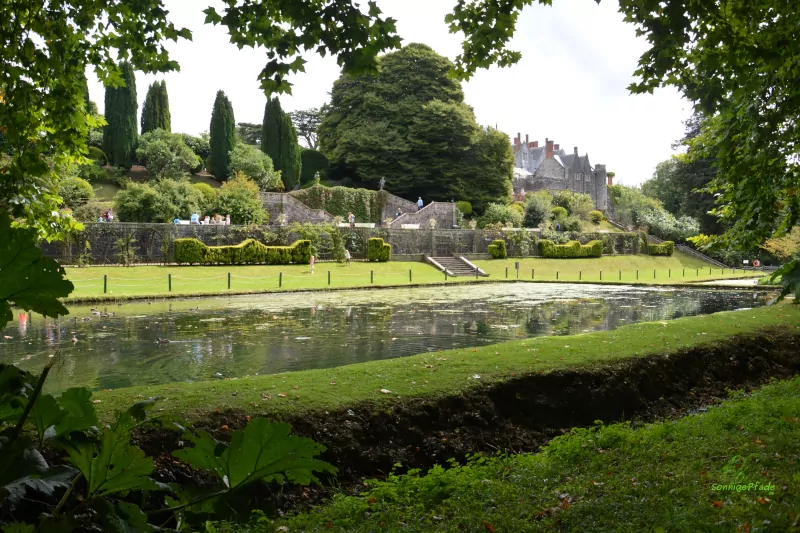
Elsewhere, a historic Welsh small town street can be found with ironmongers and colonial goods store. Even an old street urinal is not missing. Not far from it a typical terraced house – street, as it is to be found in Wales partly still. But here in each of the houses was furnished according to a different time epoch. The furnishings reflect the change, from the sparse furnishings of the first residents to the relative prosperity of the 50s and 60s, where already a large TV – box with tiny black and white picture tube in the corner. Behind the house the narrow backyard – gardens with privy, coal shed and rabbit hutch, whose yields had to contribute a little to the variety in the supply of the residents.

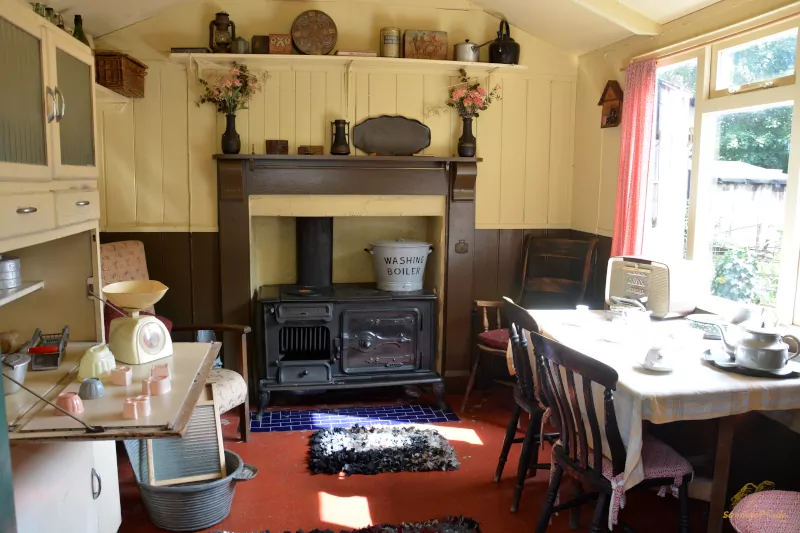
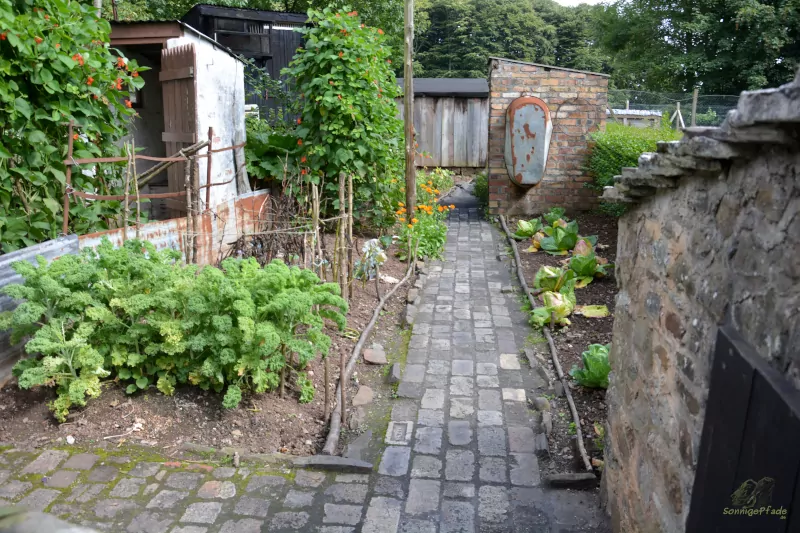
Somewhat remotely, an Iron Age settlement, the „Celtic village“, was recreated with thatched round houses.
In stark contrast to the historical show in the Welsh – life – Museum is the modern service building with solar energy supply and high ecological standards. There you can have lunch and also visit a modern toilet. You can get to the Museum of Welsh life by city bus, but you have to walk quite a distance along St. Fagan street/Cardiff street, because the line turns off into an adjacent neighborhood.
Out of Cardiff – A bus tour over the countryside
There are also great attractions to see in the countryside around Cardiff. If you don’t have a car and maybe not too many free days, then I advise you to take an organized bus tour with a minibus. Otherwise it is quite expensive to go to the different destinations by public transport. And you don’t save that much in the end. I don’t know if it was luck, but we had a really good, dedicated guide for the day who told lively stories and was a joy to be around. On our own, the tour would probably never have been as entertaining and interesting. You can book these tours e.g. in hotels or hostels, also the tourist information comes into question for it.
Caerleon – Roman army camp and ancient roman wellness temple
The first destination away from Cardiff is Caerleon, an excavated Roman fortification and settlement. This was interesting because it shows the effort the Romans put into such a stationing place far away from Rome. As Isca Silurum this Roman garrison existed for about 300 years at the river Usk. Legio II Augusta was stationed here. Excavated about 100 years ago as an archaeological monument, there is an amphitheater that could seat about 6000 people. In addition, there is an extensive bathhouse in Caerleon, which is hardly inferior to today’s wellness and bathing culture. So to speak with swimming pool, whirlpool and central heating. In the small museum not only the bathhouse is explained, but also something about the equipment and armament of the Roman soldiers as well as the construction techniques – which in turn were reinvented centuries later.
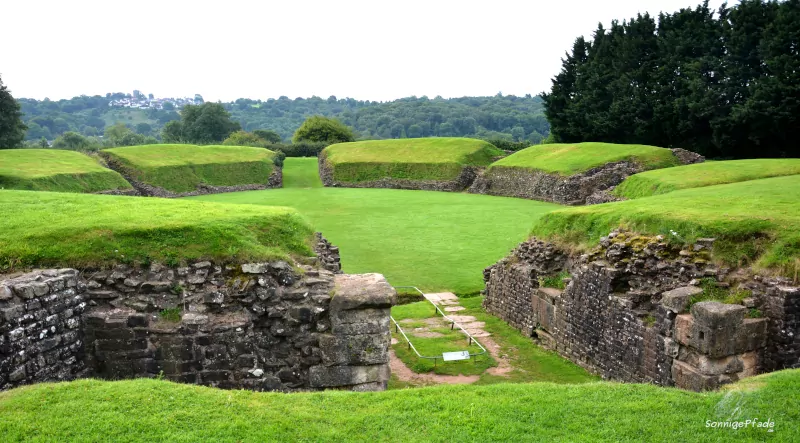

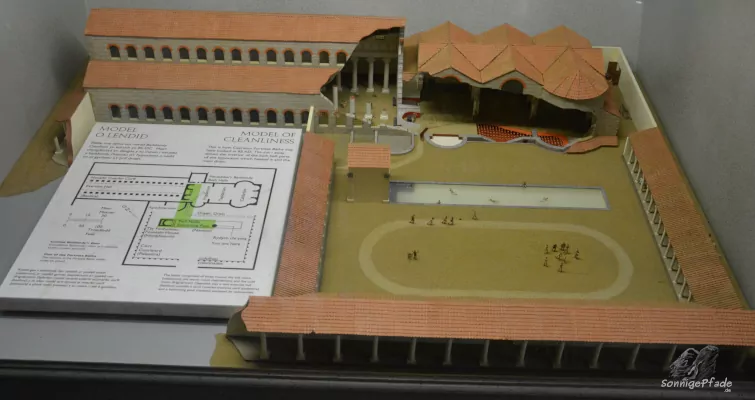
Tintern Abbey – template for Ken Follett’s Kingsbridge Priory?
Another stop on the tour is Tintern Abbey on the River Wye, which is the south Wales border river to neighboring England. Past the settlement, an old steel railroad bridge crosses the river, which today is only used by pedestrians and cyclists.
Tintern Abbey is the ruin of an important Cistercian monastery, which was founded in 1131. The monastery settlement grew rapidly. The monastery had its heyday probably at the beginning of the 14th century. At that time the larger buildings including the three-nave Gothic monastery church were completed.
The wealth of Tintern Abbey is on the one hand due to donations from noblemen. In addition, the monastery cultivated large estates on the Wye River, which yielded great returns. Only the plague in 1349 slowed down the development by causing many victims in the monastery itself as well as among the peasants who cultivated the monastery estates.
The Reformation and the establishment of the Anglican State Church sealed the end of Tintern Abbey. Under Henry VIII, the monastery was forcibly dissolved in 1536. The not inconsiderable monastic treasure fell into the hands of the Crown. The dismantling of the lead roof further exposed the church to decay.
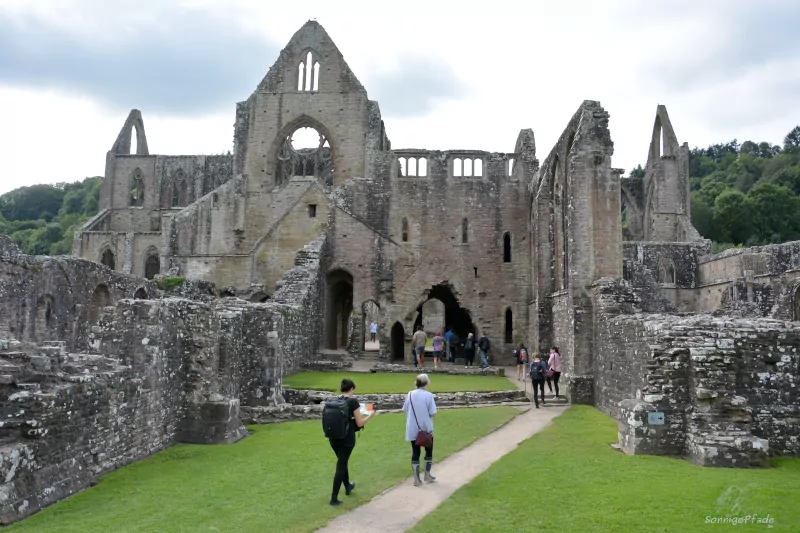

The Welsh bestselling author Ken Follett lives in Cardiff. He will probably be well acquainted with Tintern Abbey. When I visited the region, Tintern Abbey and the following castle, the obvious thought came to me, whether these stone testimonies of the Middle Ages have not inspired the imagination for the famous Kingsbridge – novels? For here, as a visitor, one quickly feels transported back to those times. In the face of the ruins of Tintern Abbey and Raglan Castle, I can well imagine that ideas quickly emerge and come together to form plots from which such an extensive work of fiction can be knitted.
The neighboring buildings also contribute to this. There is a lot of tourist hustle and bustle with souvenir stores and ice cream sales, but the old water mill, for example, fits perfectly into the „Kingsbridge picture“. The Tintern – tourism began already at the end of the 18th century. Romantics discovered the ruins of Tintern Abbey in the remote and somewhat mystical valley of the Wye River and contributed to its popularity. First efforts to conserve the walls began, and now the remains of the abbey church and the buildings are protected as monuments. Tintern Abbey is a worthwhile destination for a trip from Cardiff to southern Wales.
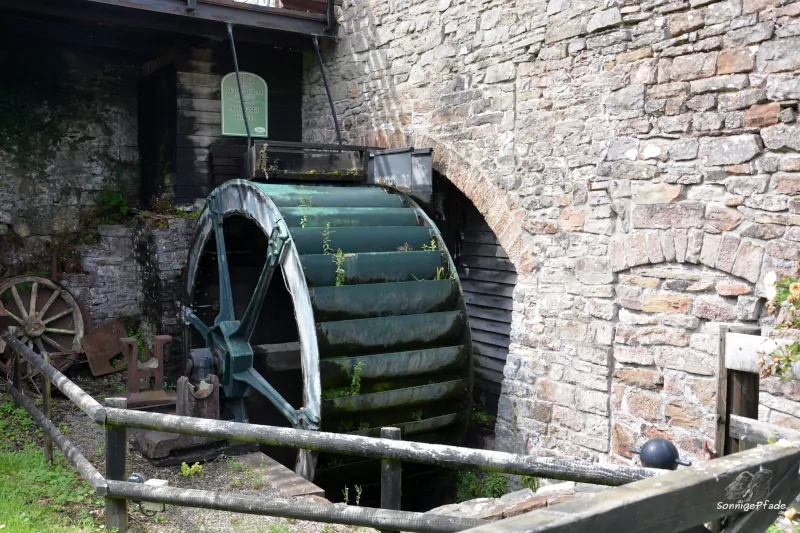
Raglan Castle – ruined castle in the countryside
Another monument of ruins in this region of South Wales is Raglan Castle. In order to explore a „robber knight – castle“, as it corresponds to the fantasies from fairy tales and adventure – stories, a visit to Raglan Castle is particularly recommended.
It is assumed that the Normans had already created a motte here as a fortification. The actual Raglan Castle was not built until the 15th century and is thus one of the last typical castle buildings on the British Isle. As the owner William Herbert was the guardian of Henry Tudor, this later King Henry VII lived at Raglan Castle for a longer period of his childhood.
In the 16th century, large parts of the castle were rebuilt like a palace with large halls of a living hall and representative rooms. Even today, the large windows – fixtures and fireplaces with reddish sandstone surrounds can be clearly seen, even if they are partially elevated at the level of the 2nd floor hanging on the walls.
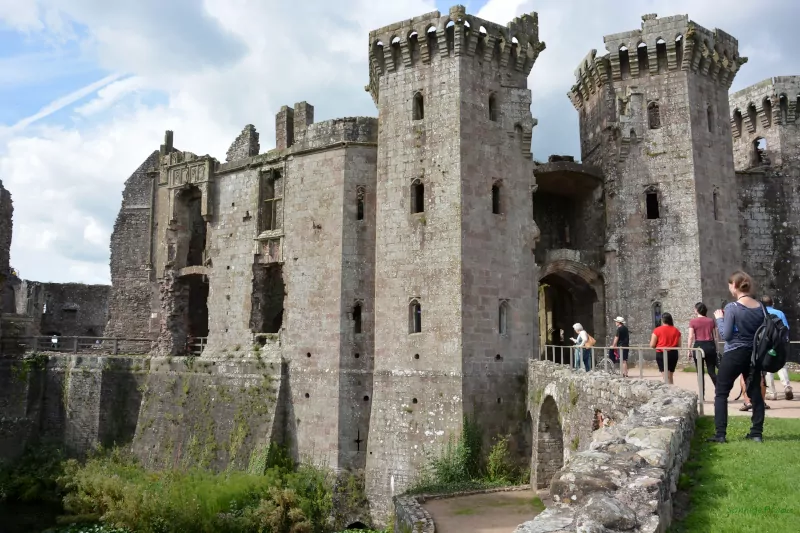
During the British Civil War, Raglan Castle became the center of activity for some time, as Royalists entrenched themselves in the castle and were besieged by the Parliamentary Army. Badly damaged, Raglan Castle was surrendered and razed in August 1646.
Until the end of the 18th century, the castle facilities were left to decay, and in some cases the stones were demolished for new buildings. Then, as in Tintern Abbey, tourism began and with it the interest in preserving the ruins.
Also Raglan Castle fits into the picture of the Kingsbridge – novel cycle of the Cardiff author Ken Follett. If you take a closer look at the ruins, you can imagine that the castle, in its various stages of construction, could have provided an idea for Earlscastle. This is the castle complex of the novel – county of Shiring, where the priory and town of Kingsbridge is said to have been located. It is not surprising that in such a region as Cardiff and southeast Wales such novels are written!
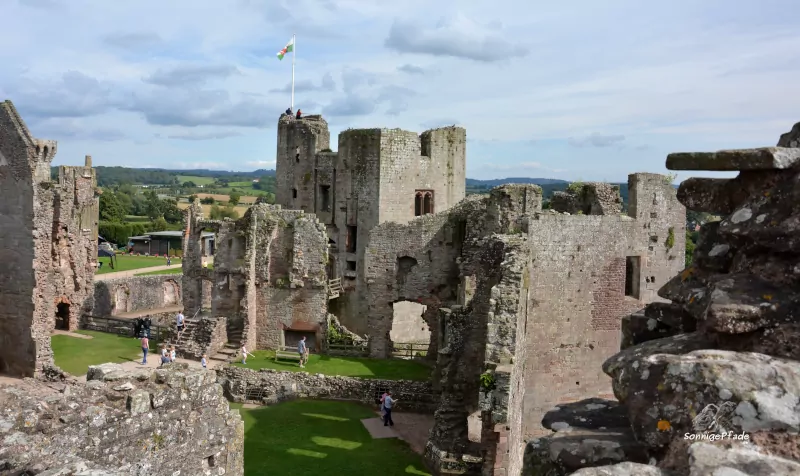
This day on an organized bus tour in South Wales ended with a visit to Raglan Castle. In my opinion, the recourse to such a local tour offer was fully worth it. With more time you can possibly make even more intensive experiences, since in particular in Caerleon probably quite some traces of Romans and other historical events are to be found more. Then maybe even the bicycle is the best means of transport for the discovery tour. But otherwise the bus ride is recommended, especially since there are still some relaxing minutes between the stops for a relaxing view out of the window on the Welsh landscape.
[Contains *advertising]
Travel tips for Cardiff
Time difference and time zone for Wales and Cardiff
In the British Isles, Western European Time applies. This corresponds to the Greenwich Mean Time (GMT) – if not adjusted by political clock games. Compared to Central Europe, this means a time difference of + one hour.
On the clock you can compare well with your own clock – the sunny-paths – clock shows the current time in Cardiff / Wales.
Weather and best travel time for Wales
Of course, I can get my knickers in a twist. We are not used to such changeable weather in Central Europe. I hope I’m not doing anything wrong when I say „You know – British Isles! Always rain, except when it’s not raining„. In any case, expect the worst – then you’ll be happy about all the sun!
Cardiff and Wales is very much influenced by the North Atlantic weather. This inevitably means lots of rain, wind, rapid changes. But especially in summer there can be longer fair weather phases, where blue sky and clouds alternate, but not a drop falls. Also the temperatures can be above 20°C in the summer – months. Nevertheless, rain protection and something to wear over it are always recommended. If the clouds cover the sun, the wind can quickly cause chilling. If you are well prepared, Cardiff and Wales will reveal its idiosyncratic beauty to you.
Winters are milder and snow is rather unlikely, but unpleasant muddy weather is. So, to experience Wales in a friendly way, use especially June, July or August for your trip.
Arrival
Cardiff has it’s own Cardiff airport. But it is small with only some connections. Alternative option for arrival ist via London. From London Victoria coach station you can take a long distance bus of National express company to Cardiff. You can check for your departures and book online – tickets at 12go – website*.
Entry to Wales and UK

Despite Brexit, the entry regulations for tourists have not changed much. The UK was never part of the European Schengen area. When entering the British Isles will always be controlled. So you need a passport or ID card.
Accommodation in Cardiff – hotels and vacation apartments
In a city like Cardiff, which is the capital of Wales, a trade fair city and a cultural center of Wales, there are of course a lot of hotels and vacation apartments of various price ranges. Coffee and tea facilities are standard in Welsh hotels. You can stay in Cardiff in a luxury hotel or as a budget traveler book an overnight stay in a cheap hostel. A small selection follows here:
Hotels and vacation apartments with star collection
With a view over Cardiff Bay and all the comforts, guests can stay at *****voco – St David’s Hotel* and enjoy their stay in South Wales. Located right on Mermaid Quay, the hotel offers a variety of luxurious rooms for two or more guests. Some of the rooms are handicapped accessible with ground level shower and wheelchair accessible beds. The hotel has a spa and wellness area with pool, Jacuzi, massages and sauna. Pets are allowed at St. David’s Hotel. There is paid parking at the hotel.
Ideal for rail travelers, the ****Clayton Hotel Cardiff* is right next to the train station. It is only a few minutes‘ walk to the city center with its promenade, Cardiff Castle and other attractions. The hotel offers a variety of double, triple and family rooms. Some rooms are also prepared for guests with handicap and for wheelchair users. There is a fitness center in the hotel.
Close to Cardiff Castle, St. David’s Concert Hall and other places of interest you will find the dignified ****Indigo Hotel*. In this hotel there are mainly two-bed rooms with possibility of extension. There is also a family room. Some rooms are prepared for wheelchair use, including low sinks and level showers. The hotel has its own fitness center.
If you’d rather resort to a luxury vacation apartment, you can find one through *****Aaron Wise Apartments*. The apartments overlook the river Taff and offer good living comfort with high quality equipment including fully usable kitchens with oven and dishwasher. The top attraction Cardiff Castle is about 500m away.
Less expensive accommodations in Cardiff
The Coal Exchange Hotel* on Cardiff Bay has a much lower star rating but a good guest review. The hotel’s room occupancy ranges from twin to large family rooms. A specially equipped room for guests with mobility impairments, as well as the hotel’s elevator, allows for wheelchair use. Cardiff Bay’s new center at Mermaid Quay is only about 300 yards away. To Cardiff Castle you can walk, take a water bus on the River Taff or a city bus.
Close to Cardiff train station you will find good and cheap accommodation at Sleeperz Hotel*. This hotel offers twin rooms and also family rooms with double bunk beds for the children. Some rooms are specially designed for disabled guests and are wheelchair accessible. It is about 600m walk to the main attraction Cardiff Castle.
A little further out of Cardiff city center is the Tanes Hotel* with single, twin and triple rooms. Some rooms have private bathrooms, others have shared bathrooms. The city center is 1.5km away on foot or by city bus. There is free public parking in the vicinity of the hotel.
A vacation apartment at Cardiff Bay* with the best facilities for two to max. four guests is the offer at Cadogan House. Here you can settle down for longer and live like at home – spacious living room, kitchen and a friendly bathroom with washing machine make this vacation apartment the starting point for an extended Wales – tour. Rental bicycles can be arranged.
Cardiff budget – hostel – accommodation
A budget accommodation in Cardiff offers the Bunk house hostel*, about 300m from the city center. Bunk house hostel has dormitories for 6 and more guests, both mixed-gender and female-only. Lockable lockers are available in the hostel for your own luggage.
Money in Wales
Even if after the Brexit it is not yet clear where the journey goes – Wales still belongs to the United Kingdom (UK) and the currency is the British Pound. The currency calculator in the right column helps you to find out the current exchange rate of any other currency to the British Pound.
You can get cash with credit card or cash card (mastercard) at many ATMs in Cardiff.
Already thinking about Cardiff and South Wales? Invite your friends!
If you liked the post and want to head to Cardiff soon, share the link to the post on your social media channels and invite your friends. Thank you!
Note on * advertising links
This post contains single links with *. These are advertising links that lead to stores or agencies. If you order something there, the sonnige pfade blog receives a small commission to cover the technical expenses. Nothing will be more expensive for you, because the commission has already been taken into account in the pricing.
Image source: Product images – Manufacturer / Dealer




